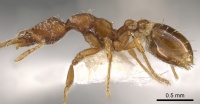Strumigenys insula
| Strumigenys insula | |
|---|---|

| |
| Scientific classification | |
| Kingdom: | Animalia |
| Phylum: | Arthropoda |
| Class: | Insecta |
| Order: | Hymenoptera |
| Family: | Formicidae |
| Subfamily: | Myrmicinae |
| Tribe: | Attini |
| Genus: | Strumigenys |
| Species: | S. insula |
| Binomial name | |
| Strumigenys insula (Bolton, 2000) | |
Nothing is known about the biology of Strumigenys insula.
Identification
Bolton (2000) - A member of the Strumigenys capitata-group. S. insula is very much an oddity in the capitata-group but most certainly a member of it. The long, apically tapered humeral hairs are reminiscent of those seen in Strumigenys rhea and Strumigenys serraformis, but Strumigenys insula lacks the specialised petiole shape and elongate mandibles of these species. At the same time the humeral hairs apparently preclude close relationship with the capitata-complex (see notes under Strumigenys tethys, Strumigenys theia, etc. ) where they are stout and tend to be either remiform or clavate apically. The absence of flagellate hairs distinguishes it from the Strumigenys dohertyi and Strumigenys mumfordi complexes, leaving insula isolated in terms of morphology as well as geography.
Keys including this Species
Distribution
Distribution based on Regional Taxon Lists
Indo-Australian Region: French Polynesia (type locality).
Distribution based on AntMaps
Distribution based on AntWeb specimens
Check data from AntWeb
Countries Occupied
| Number of countries occupied by this species based on AntWiki Regional Taxon Lists. In general, fewer countries occupied indicates a narrower range, while more countries indicates a more widespread species. |

|
Estimated Abundance
| Relative abundance based on number of AntMaps records per species (this species within the purple bar). Fewer records (to the left) indicates a less abundant/encountered species while more records (to the right) indicates more abundant/encountered species. |

|
Biology
|
Castes
Nomenclature
The following information is derived from Barry Bolton's Online Catalogue of the Ants of the World.
- insula. Pyramica insula Bolton, 2000: 400 (w.) FRENCH POLYNESIA (Tahiti). Combination in Strumigenys: Baroni Urbani & De Andrade, 2007: 121
Unless otherwise noted the text for the remainder of this section is reported from the publication that includes the original description.
Description
Worker
Holotype. TL 2.8, HL 0.68, HW 0.51, CI 75, ML 0.14, MI 21, SL 0.34, SI 67, PW 0.37, AL 0.76. Apicoscrobal hair simple, somewhat blunted apically but not remiform nor clavate, and certainly not flagellate. Dorsum of head close to occipital margin with a transverse row of 4 standing hairs, and with a pair of similar hairs situated close to the highest point of the vertex. Eye with 5 ommatidia in the longest row. Entirety of head finely and densely reticulate-punctate; cephalic ground-pilosity of slightly elevated sparse short spatulate hairs. Pronotal humeral hair long, simple and curved, tapered to a pointed apex. Mesonotal dorsum with two pairs of remiform standing hairs (anterior pair abraded in holotype). Remiform hairs also present on dorsum of petiole node (2 pairs), on postpetiole disc (4 pairs) and on first gastral tergite where numerous hairs are arranged in 4-5 uneven transverse rows. Pronotum without a median longitudinal carina, reticulate-punctate, the punctures effaced dorsally and the surface with a series of transversely arched extremely fine rugulae. Side of alitrunk with katepisternum and anteromedian patch of metapleuron smooth. Propodeal teeth very short, triangular. With petiole in profile the height of the anterior face of the node only slightly less than the length of the dorsal surface (discounting the posterior collar), and the lateral lobe of the node broad and spongiform. Lateral and ventral spongiform lobes of postpetiole large, the latter distinctly larger than the exposed cuticular area of the disc. Petiole node in dorsal view conspicuously broader than long, mostly smooth and shining with only the faintest vestiges of scattered punctulae. Sides of petiole node bordered almost to the anterolateral angles by spongiform tissue of the lateral lobes. Postpetiole disc broader than long and glassy smooth. Basigastral costulae very sharply defined and forming an uninterrupted row across the tergite, their length about equal to the maximum length of the postpetiole disc.
Paratype. TL 2.7, HL 0.68, HW 0.51, CI 75, ML 0.14, MI 21, SL 0.34, SI 67, PW 0.35, AL 0.75. As holotype but pronotal dorsum reticulate-punctate everywhere, the punctures somewhat effaced anteromedially but the surface lacking the arched rugulae seen in the holotype.
Type Material
Holotype worker, Tahiti: Mont Tentara, 1000 m., 28.i.1982 (G. H. Perrault) (Museum of Comparative Zoology).
Paratype. 1 worker with same data as holotype (The Natural History Museum).
References
- Baroni Urbani, C. & De Andrade, M.L. 2007. The ant tribe Dacetini: limits and constituent genera, with descriptions of new species. Annali del Museo Civico di Storia Naturale “G. Doria” 99:1-191.
- Bolton, B. 2000. The ant tribe Dacetini. Memoirs of the American Entomological Institute. 65:1-1028. (page 400, worker described)
References based on Global Ant Biodiversity Informatics
- Ramage T. 2014. Les fourmis de Polynesie francaise (Hymenoptera, Formicidae). Bulletin de la Société entomologique de France 119 (2): 145-176.

